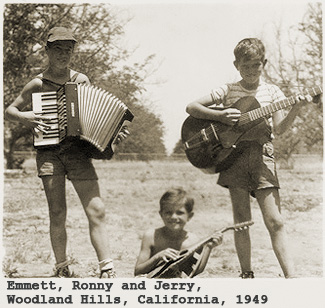|
Emmett Chapman: The Beginning (1936-1969)
Page 1 2 3 4
by Jim Reilly
School Days
 The move back to California and Venetia's marriage to Laverne brought stability into Emmett's life — stability built on a foundation of change. Later, Emmett would embrace change, would seek it out. When he talks of his childhood, Emmett mentions that the one constant was a compulsion to change. While change may be seen as instability, this does not ring true with Emmett. Nor does the idea that change occurs only for its own sake. Emmett says that as a child, he saw no difference between sports, music, academics or other endeavours. They were all challenges, simply things to pour himself into. Emmett calls them, "active, positive" things, rather than merely activities to keep busy. No one thing was more important than any other. The young Emmett favoured action over talk, choosing to act rather than contemplate actions. "While growing up," Emmett says, "I felt I had natural talents in many directions."
The move back to California and Venetia's marriage to Laverne brought stability into Emmett's life — stability built on a foundation of change. Later, Emmett would embrace change, would seek it out. When he talks of his childhood, Emmett mentions that the one constant was a compulsion to change. While change may be seen as instability, this does not ring true with Emmett. Nor does the idea that change occurs only for its own sake. Emmett says that as a child, he saw no difference between sports, music, academics or other endeavours. They were all challenges, simply things to pour himself into. Emmett calls them, "active, positive" things, rather than merely activities to keep busy. No one thing was more important than any other. The young Emmett favoured action over talk, choosing to act rather than contemplate actions. "While growing up," Emmett says, "I felt I had natural talents in many directions."
When he was thirteen, Emmett's grandmother gave him an accordion — his first musical instrument. Approaching music with the same enthusiasm and energy that he approached everything else in his young life, Emmett quickly became competent and comfortable enough to play in public. His first performances were for church services, family, and friends. According to Emmett, he played "original chordal arrangements of well known hymns and standards."
Emmett's first musical influences were his mother and the show tunes and international songs she sang for family and visitors as he was growing up. From those early days music was always around but never Emmett's main focus until 1959 when began gigging in the clubs along Ventura Boulevard and soon was making enough money to support the family and continue his studies at UCLA. Long before that, the pianist in Emmett's church, Sister Moody, gave him his first accordion lessons. The piano continued to inspire. One day, in second grade, he heard the passing tones and inner moving voices his teacher was playing on the piano. This fascinated him, he was responding to something that he naturally heard but hadn't had exposure to before. It opened up an emotional range of music that Emmett had never heard on his mother's guitar.
Shortly after his first accordion performances, he began playing "one-handed piano" at their local church in Woodland Hills. Emmett played piano with an accordion technique: the right hand playing only chords. Soon, he added one-finger bass lines with his left hand on the lower notes of the piano. From the beginning of Emmett's musical life, chords fascinated him. Chords create harmony. "Chords create a meaningful context for even the simplest melody," says Emmett.
In school Emmett continued to move in many directions. He was the editor-in-chief of his high school's student newspaper, the Hunters' Call, at Canoga Park High School. He even drew the school's logo. He excelled at visual arts and was called on to create posters for school elections, sporting events and dances. Emmett also excelled at sports. Cross-country running was his forte but he also made a name for himself playing tennis. Without any formal tennis lessons, by sheer will and determination, he was able to make his way up through the school ranks from 33rd to a very respectable 3rd. Music didn't play an overly prominent role in Emmett's school experience. He carried a ukulele around with him and would strum guitar chords and lead sing-alongs, but school for Emmett was more of a feast of experiences, each approached with a similar enthusiasm and will to succeed.
go to page 3
|
|

